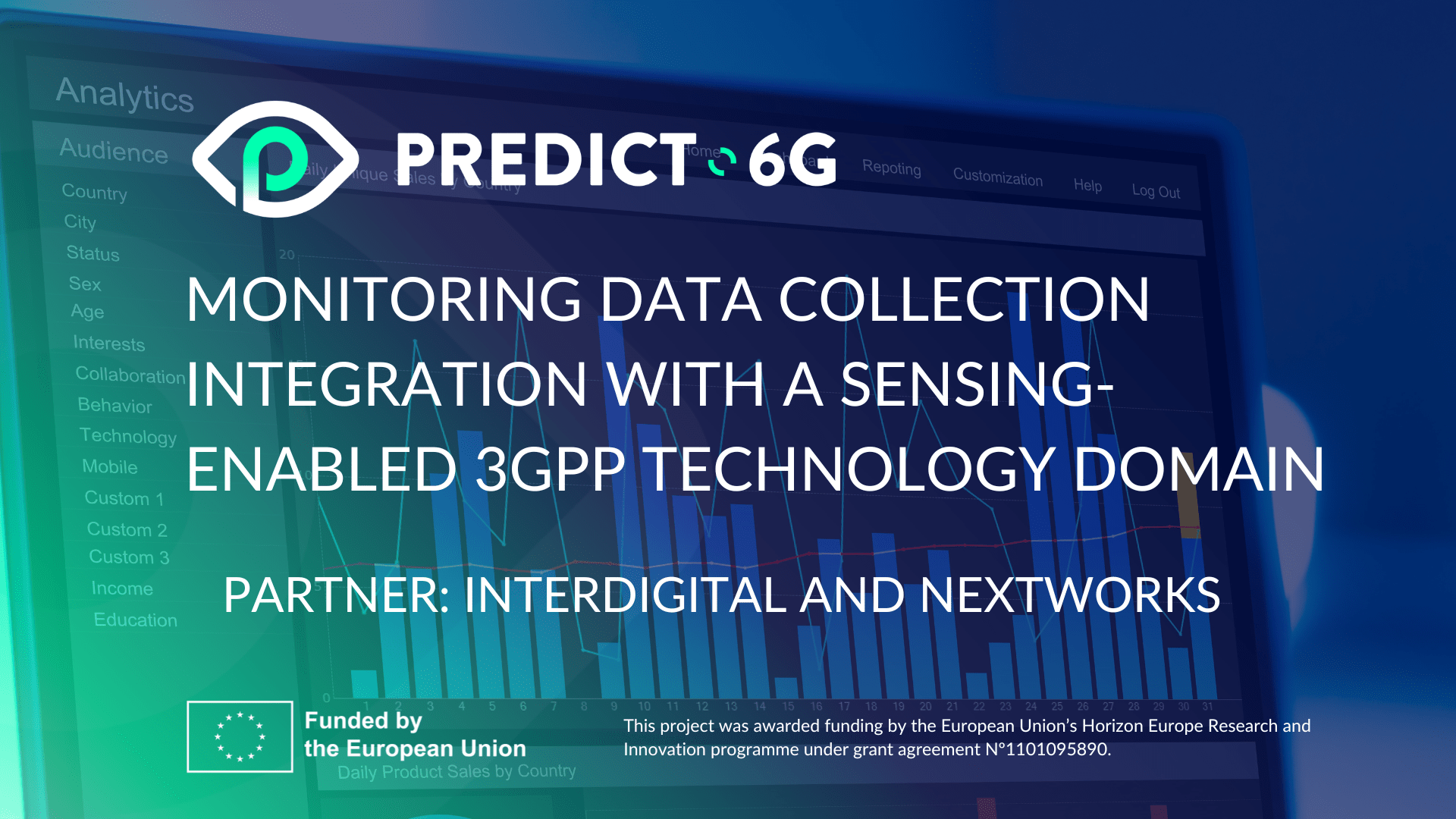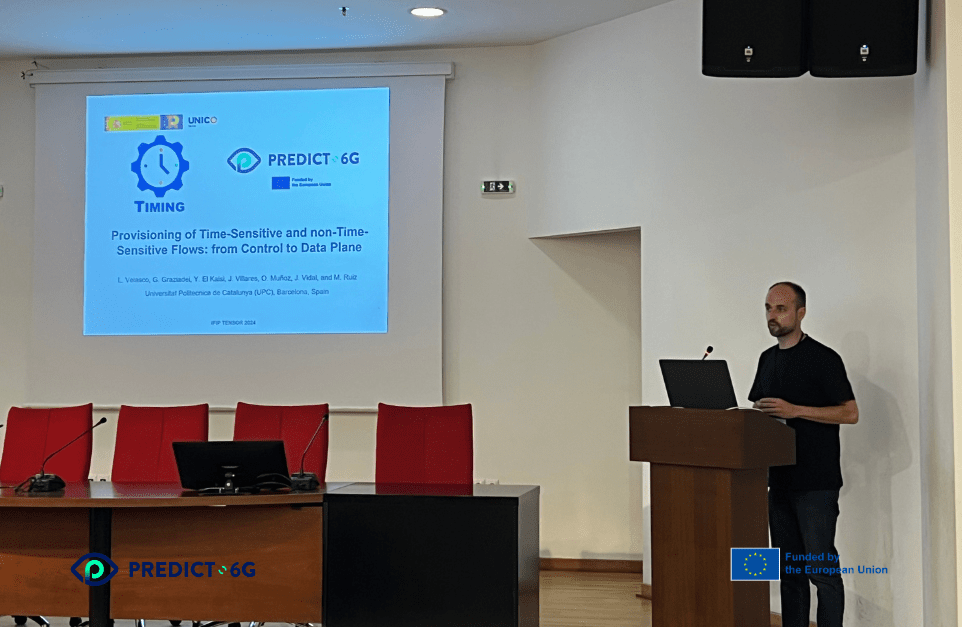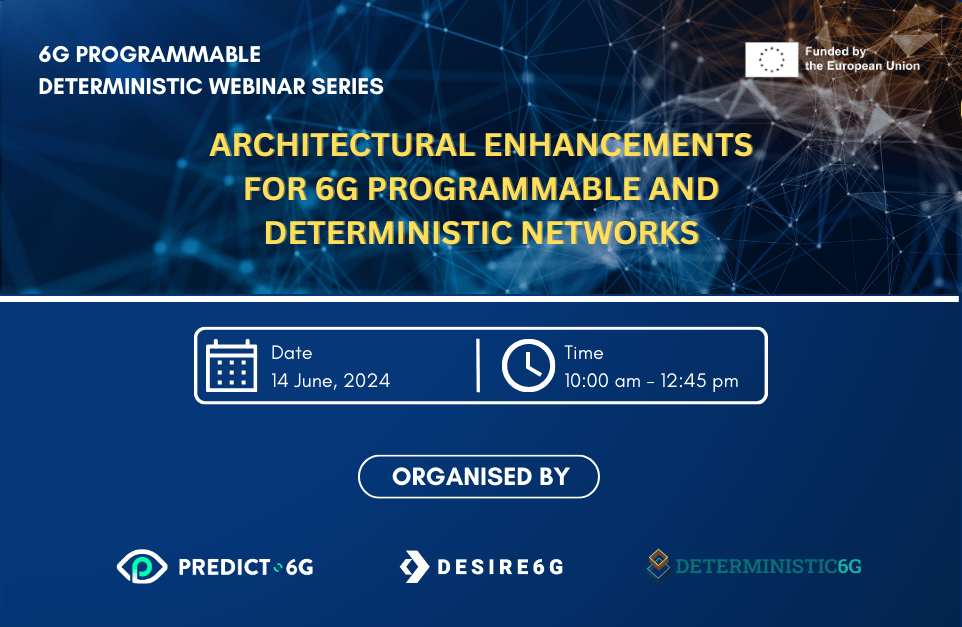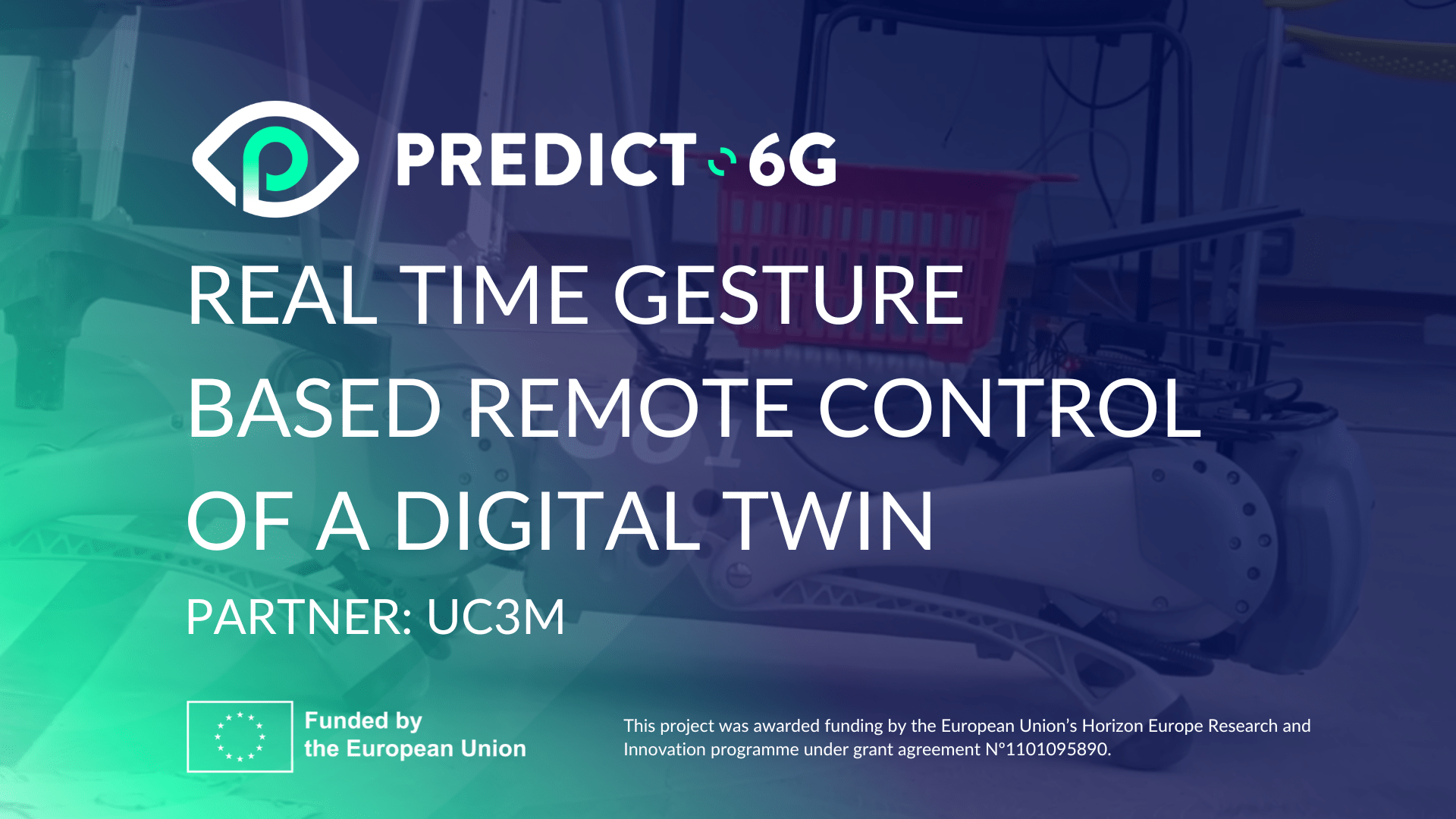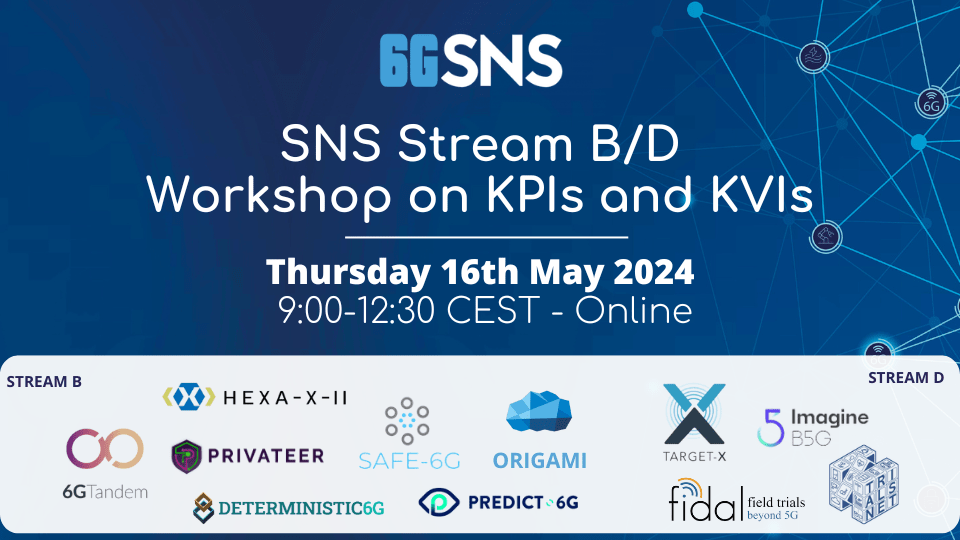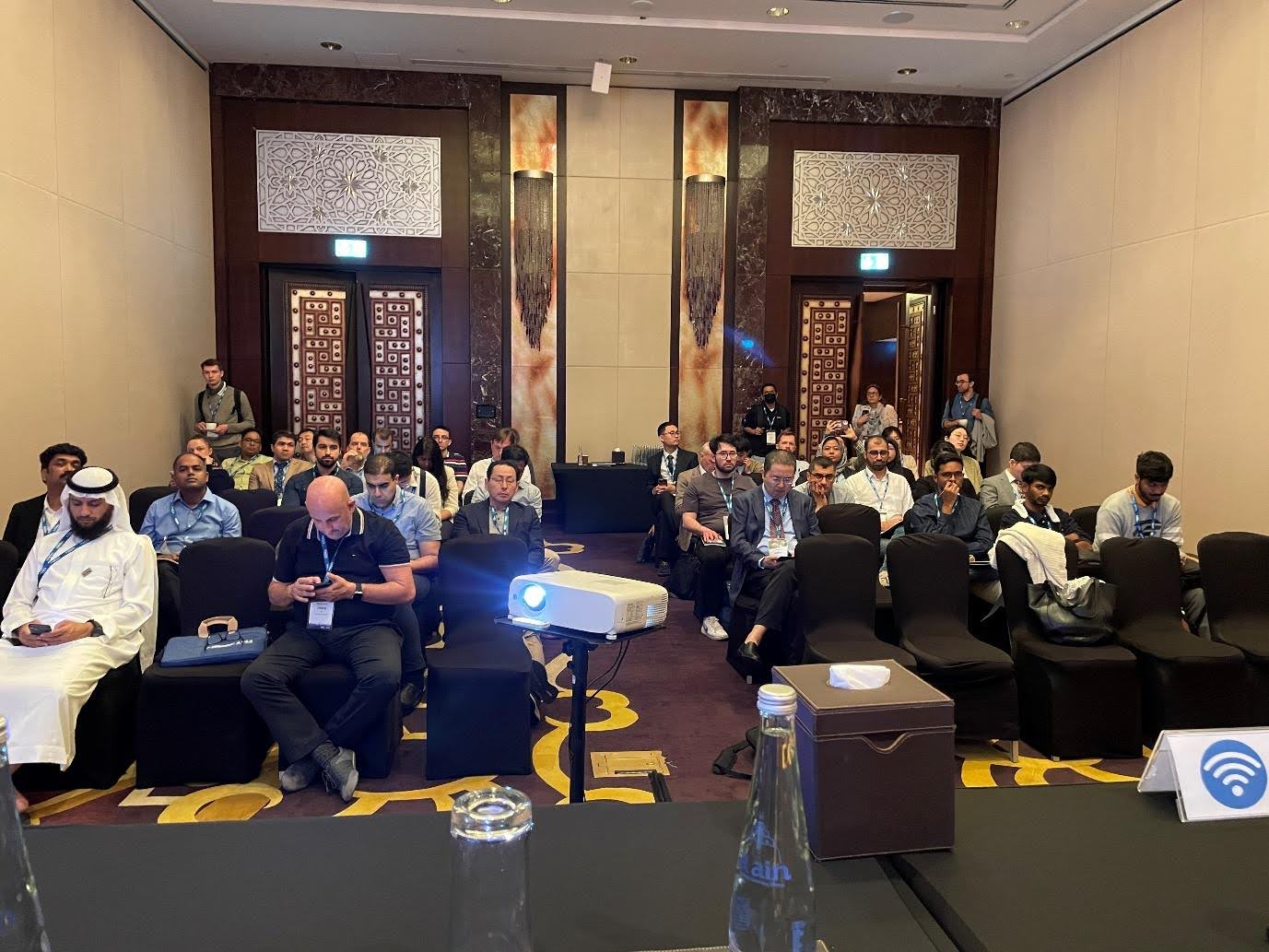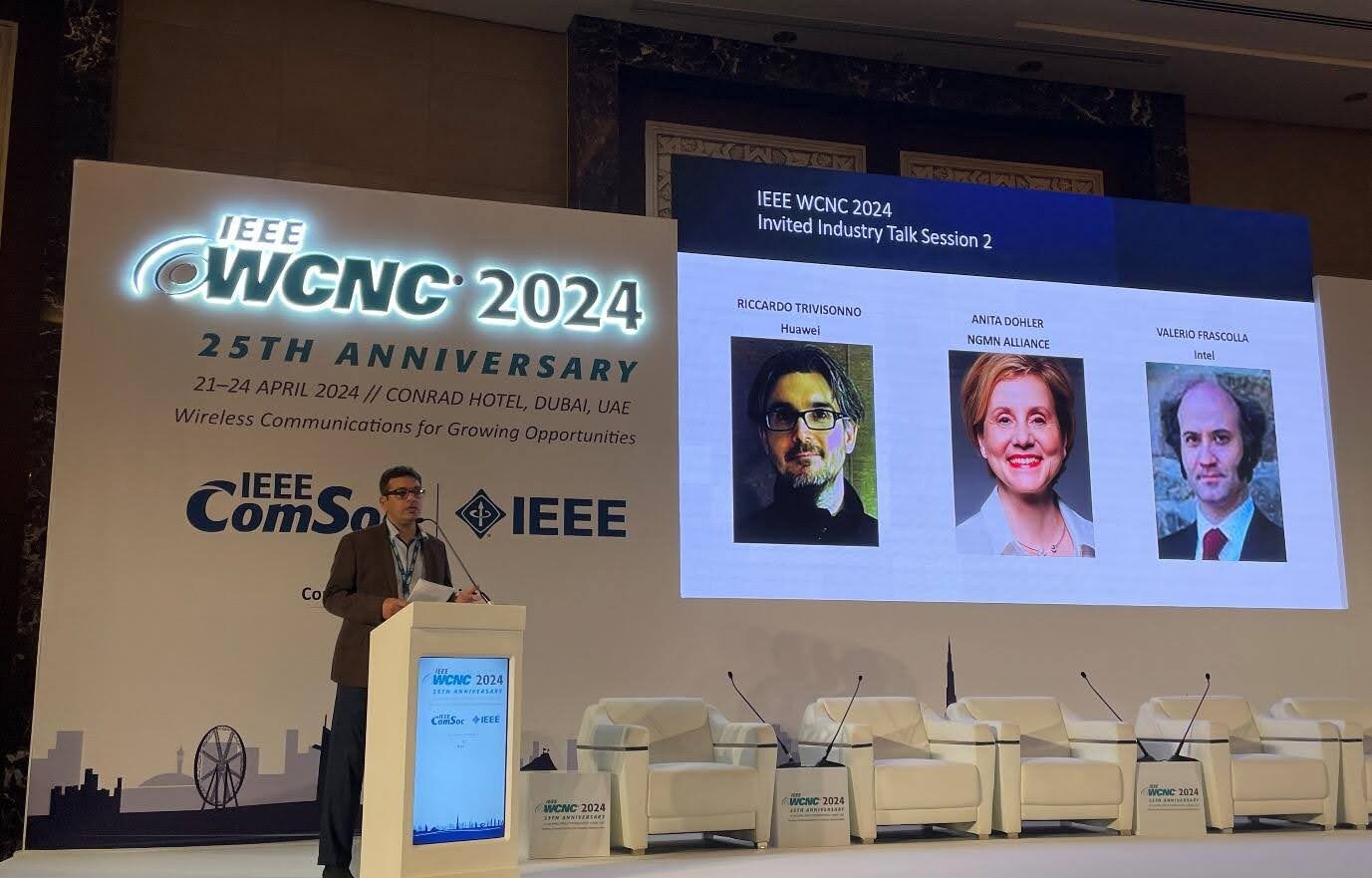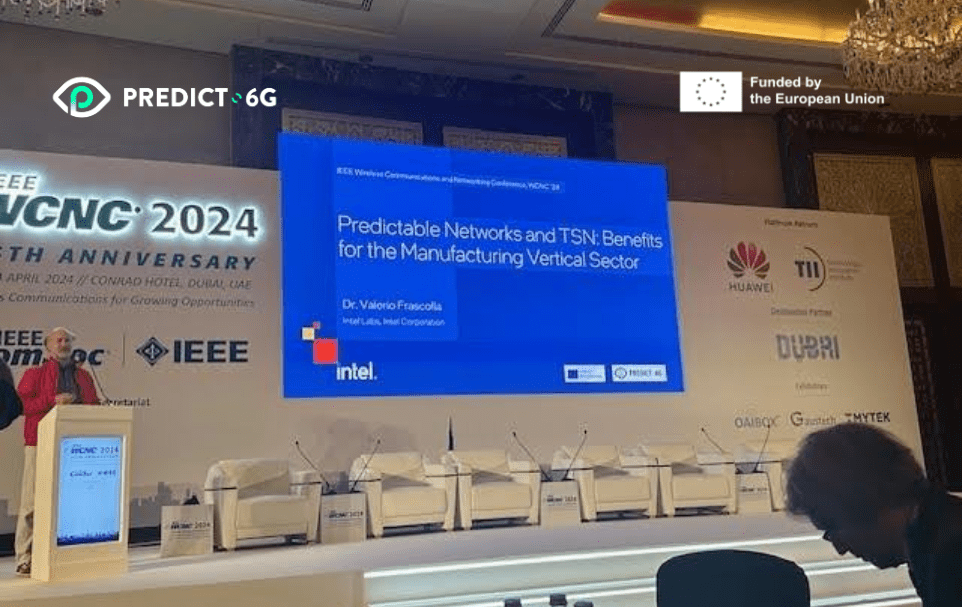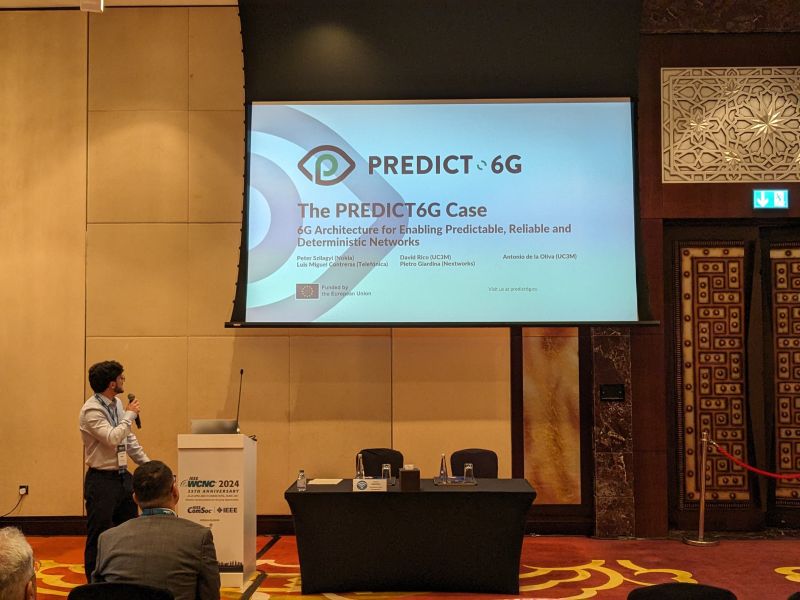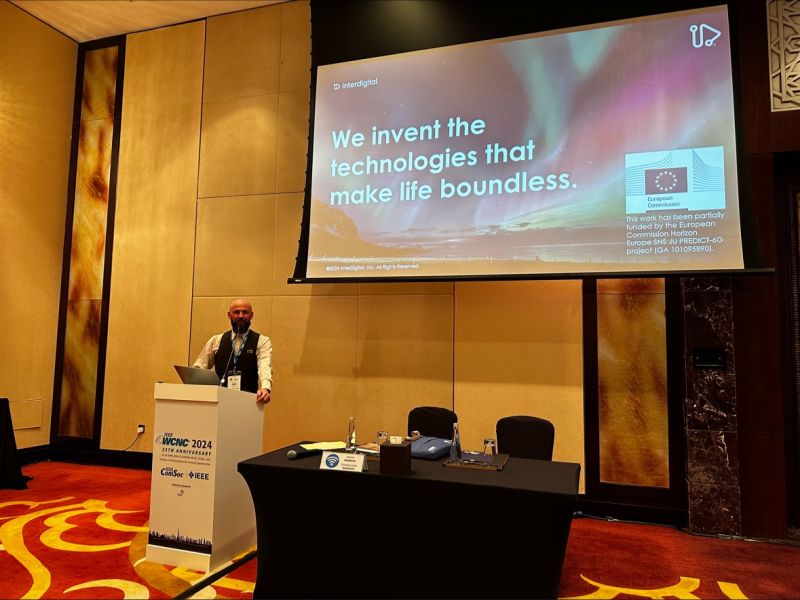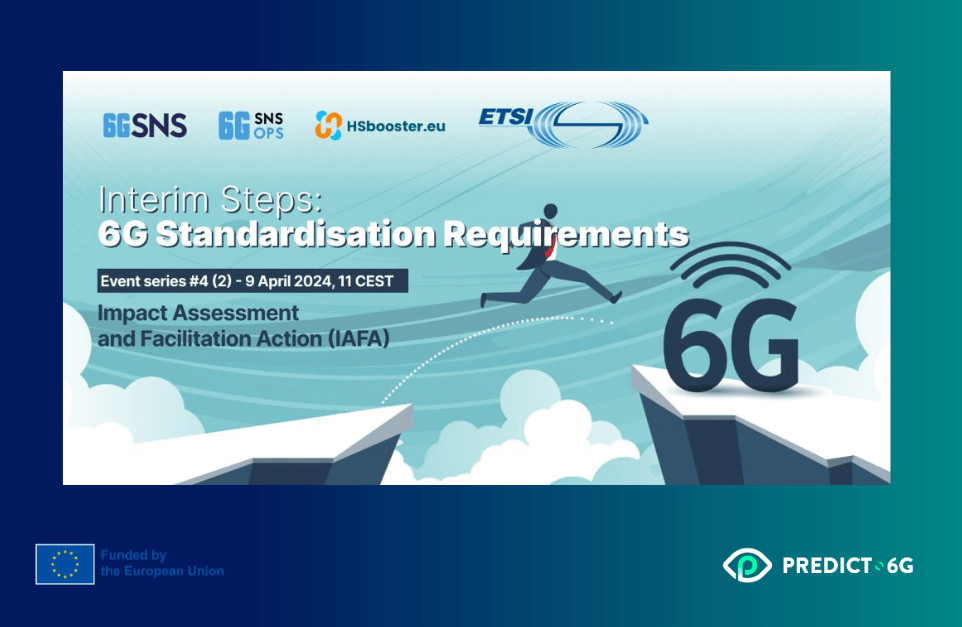DEMO: Monitoring Data collection Integration with a Sensing-Enabled 3GPP Technology Domain
Use cases are at the heart of PREDICT-6G. They are the way for our research and use case providers to experiment, validate and demonstrate how PREDICT-6G technologies enable a reliable, predictable and time-engineered 6G network. Sebastian Robitzsch from InterDigital and Matteo Ravalli from Nextworks led the "Monitoring Data collection Integration with a Sensing-Enabled 3GPP Technology Domain" demo.
This demonstration presents a Multi-Domain Monitoring Data collection for the PREDICT-6G project. It automates the collection of Layer 4 latency and sensing data from a 3GPP domain, feeding it into an AI-driven control plane and a digital twin application. The demonstration integrates the AI-driven control plane (AICP) to manage service provisioning and data monitoring.
Key features include:
- Collection of node information, link characteristics and sensing data.
- Real-time data processing and storage for AI and digital twin processes.
- Creation and configuration of data sources and consumers with specific permissions.
- Measuring round-trip time and link latencies using probes.
Overall, the demonstration shows how to collect, process and use multi-domain data to improve network management in a 6G environment.
You can watch the demo here and below.
If you want to stay updated about PREDICT-6G, subscribe to our newsletter and follow us on Twitter and LinkedIn!
International Federation for Information Processing (IFIP) Networking 2024 Conference
The International Federation for Information Processing (IFIP) Networking 2024 Conference was held from 3 to 6 June in Thessaloniki, Greece. The main objective of this year's edition was to bring together academic and industrial experts of the networking community to discuss the most recent advances in networking, to highlight key issues, identify trends, and develop a vision of the future Internet from a design, deployment and operation standpoints. The sessions and workshops were designed with a special focus on network architectures, applications and services; network modeling, analysis and operation; network security and privacy; and wireless networking.
PREDICT-6G was part of the IFIP Networking Conference with a paper authored by Luis Velasco and Marc Ruiz from Universitat Politècnica de Catalunya, among others. The paper, titled "Provisioning of Time-Sensitive and non-Time-Sensitive Flows: from Control to Data Plane", was presented by Marc at the 4th International Workshop on Time-Sensitive and Deterministic Networking (TENSOR) 2024. The goal of this workshop was to bring together researchers from academia and industry in order to investigate challenging aspects in the area of time- sensitive deterministic communications, as well as identify future research directions for ultra-low latency communications.
"Time-Sensitive Networking (TSN) standards provide scheduling and traffic shaping mechanisms to ensure the coexistence of Time-Sensitive (TS) and non-TS traffic classes on the same network infrastructure. Nonetheless, much effort is still needed on the operation of such TSN capable network infrastructure to ensure that the required performance of the different flows, defined in terms of key performance indicators, can be met once the flows are deployed in the network. In this presentation, we focused on such aspects and proposed a solution involving not only packet schedulers in the data plane, but also network-wide scheduling for TS flows, as well as performance estimation for non-TS flows", stated Marc Ruiz.
The paper is available here.
If you want to stay updated about PREDICT-6G, subscribe to our newsletter and follow us on Twitter and LinkedIn!
6G Programmable Deterministic Webinar Series: #1 Architectural enhancements for 6G programmable and deterministic networks
We are pleased to announce the 6G Programmable Deterministic Webinar Series, a collaborative initiative between PREDICT-6G, DESIRE6G and DETERMINISTIC6G. This quarterly series aims to delve into the intricate and transformative aspects of these sister projects, featuring expert speakers that will explore the latest developments and innovations shaping the future of 6G technology. Each session will provide in-depth information and foster key discussions for practitioners and researchers dedicated to the next generation of wireless communications.
The first webinar will take place on Friday 14 June at 10:00 CET. Under the title ‘Architectural enhancements for 6G programmable and deterministic networks’, it will feature Peter Szilagyi from Nokia, Chrysa Papagianni from the University of Amsterdam, Joachim Sachs from Ericsson and Gourav Prateek Sharma from KTH, followed by a panel discussion on the topic.
Agenda
- 10-10:10. Intro by Carlos J. Bernardos (UC3M)
- 10:10-10:50. Peter Szilagyi (Nokia): “Multi-domain deterministic service management architecture”
- 10:50-11:30. Chrysa Papagianni (University of Amsterdam): "Towards extreme network KPIs with deep programmability in 6G”
- 11:30-12:10. Joachim Sachs (Ericsson) and Gourav Prateek Sharma (KTH): "5G latency analysis and possible improvements"
- 12:10-12:40. Panel: "Architectural enhancements for 6G programmable and deterministic networks"
- 12:40-12:45. Closure
Register here: https://ec.europa.eu/eusurvey/runner/WS1June2024
Link to webinar: https://us06web.zoom.us/j/87094846948
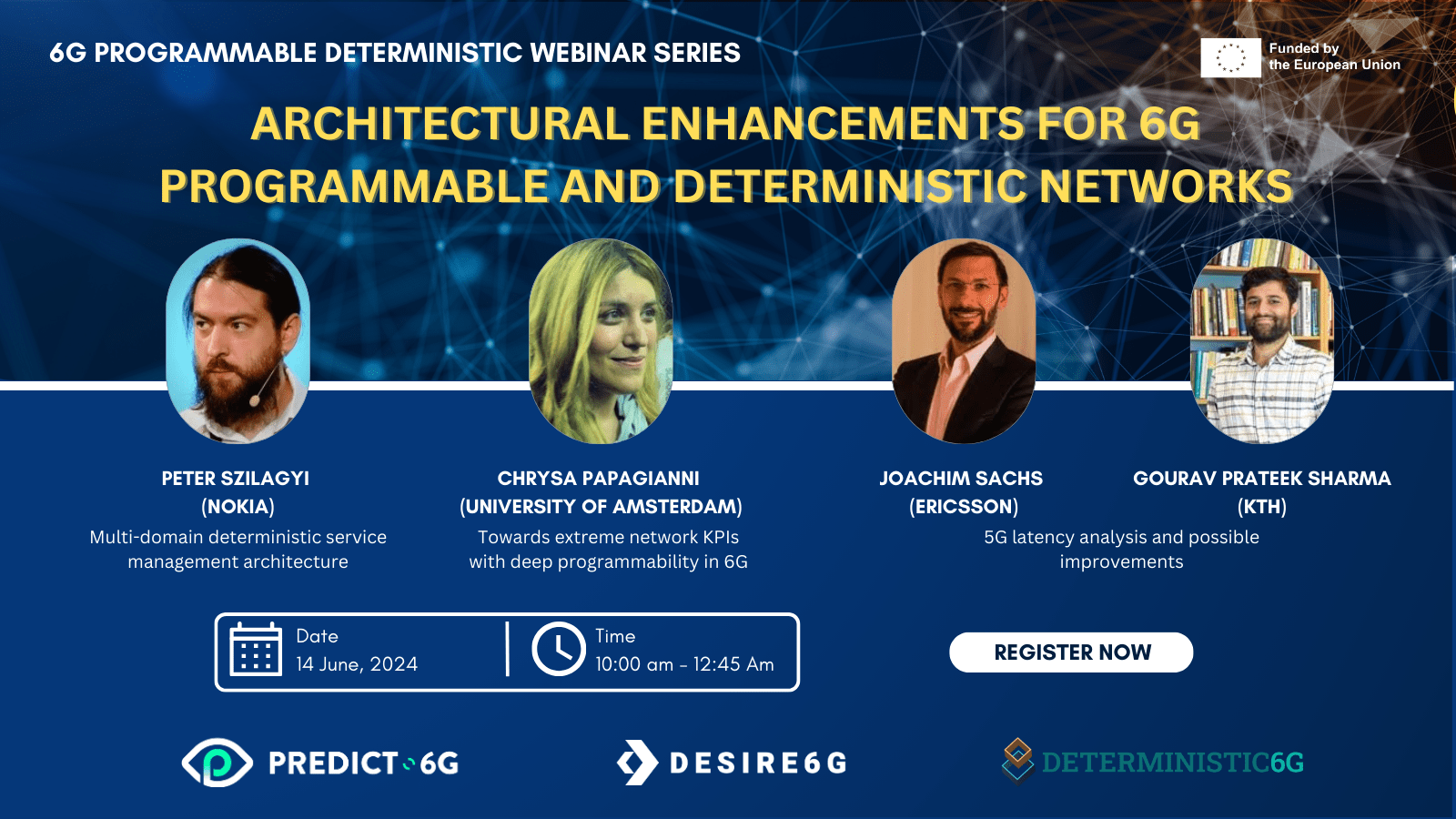
If you want to stay updated about PREDICT-6G, subscribe to our newsletter and follow us on Twitter and LinkedIn!
DEMO: Real Time Gesture Based Remote Control Of A Digital Twin (UC3M)
Use cases are at the heart of PREDICT-6G. They are the way for our research and use case providers to experiment, validate and demonstrate how PREDICT-6G technologies enable a reliable, predictable and time-engineered 6G network. Antonio de la Oliva, Associate Professor at Univesidad Carlos III de Madrid (UC3M), and PREDICT-6G coordinator, led the "Real Time Gesture Based Remote Control Of A Digital Twin" demo.
This demonstration shows how the combination of three different key technology enablers can allow us to remotely control a robotic dog using gestures. During the demonstration it can be seen how we have a full three-dimensional model of the robotic dog. It can also be seen how we have a full three-dimensional model of the robotic dog and the robot perfectly in real time, thanks to ultra-reliable, low-latency communications.
You can watch the demo here and below.
IEEE International Conference on Computer Communications
IEEE International Conference on Computer Communications (IEEE INFOCOM) took place from 20 - 23 May in Vancouver, Canada. IEEE INFOCOM is a top-ranked conference on networking in the research community. Consortium member Politecnico di Torino participated in INFOCOM with two papers presented at the main conference.
“OREO: O-RAN intElligence Orchestration of xApp-based network services” introduces OREO, an Open Radio Access Network (O-RAN) xApp orchestrator, designed to maximize the number of offered services. OREO’s key idea is that services can share xApps whenever they correspond to semantically equivalent functions, and the xApp output is of sufficient quality to fulfill the service requirements. The paper is available here.
“Resource-aware Deployment of Dynamic DNNs over Multi-tiered Interconnected Systems” tackles the problem of allocating sections of Modern dynamic deep neural networks (DNN) with early exits to the nodes of the mobile-edge-cloud system. By envisioning a 3-stage graph-modeling approach, it represents the possible options for splitting the DNN and deploying the DNN blocks on the multi-tiered network, embedding both the system constraints and the application requirements in a convenient and efficient way. The paper is available here.
If you want to stay updated about PREDICT-6G, subscribe to our newsletter and follow us on Twitter and LinkedIn!
SNS Stream B/D Projects Workshop on KPIs and KVIs
In May 2024, PREDICT-6G participated in the “SNS Stream B/D Projects Workshop on KPIs and KVIs” organised by the SNS Technology Board. In the first session, Stream D projects discussed the requirements (KPIs) from UCs large-scale trials and validation methodology (KVIs), whilst in the second session Stream B projects shared their perspectives on technology highlights on target performances (KPIs) and impacts (KVIs).
Marc Molla (Ericsson) presented PREDICT-6G KPIs and KVIs. The KVIs are categorised into latency (service latency and jitter), packet loss (packet loss and packet ordering) and service (reliability and availability). The KVIs of the project are related to the ecosystem (business value and economic growth) and security.
The presentation can be found here.
More detailed information about the KPIs can be found in D1.1. Analysis of use cases and system requirements.
If you want to stay updated about PREDICT-6G, subscribe to our newsletter and follow us on Twitter and LinkedIn!
PREDICT-6G celebrates the Citizen Science Month
Determinism, 6G, reliability or predictability are just some of the words at the core of PREDICT-6G work. Setting a common understanding on these concepts is therefore essential to efficiently communicate about the different activities carried out by the project team, inviting the participation of the community as well as the society at large into the research.
With this in mind, PREDICT-6G joined the Citizen Science Month with a social media campaign shedding light on some of the most common concepts used in the project. During April 2024, there were various publications explaining the meaning of the keywords that have come to constitute the shared vocabulary of the PREDICT-6G team.
The engagement of the community with the campaign was highly positive, including several remarks about the value of contributing to set a common ground to speak about deterministic networks.
If you want to stay updated about PREDICT-6G, subscribe to our newsletter and follow us on Twitter and LinkedIn!
IEEE Wireless Communications and Networking Conference (WCNC)
By Valerio Frascolla
The IEEE Wireless Communications and Networking Conference (WCNC) 2024, with the theme “Wireless Communications for Growing Opportunities”, took place from 21-24 of April 2024 in Dubai, United Arab Emirates. The 2024 edition presented a full programme of high quality, including technical sessions, tutorials and workshops, as well as technology and industry panels. PREDICT-6G was a key contributor to the success of the Industry Programme.
On the 22 of April, Dr. Valerio Frascolla, Director of Research and Innovation at Intel and PREDICT-6G Innovation Manager, was invited to be a panellist in the “6G: Midway Status and Way Forward” panel led by Majid Butt (Nokia), with Mikko Uusitalo (Nokia), Paulina Chan (Principal and CEO of Global Mutual Innovation Consortium), and Anita Dohler (CEO NGMN Alliance).
During the panel an interesting and active discussion was held with the audience of around 40 participants on the status of 6G, its standardisation plans, current architecture options and expected benefits. The PREDICT-6G position on the need in 6G for a smoother convergence of cellular and non-cellular (Wi-Fi) wireless technologies was a pivotal argument of the discussion.
On the 23 of April, Dr Frascolla gave the Invited Talk “Predictable Networks and TSN: Benefit on the Manufacturing Vertical Sector” at the industry Talk Session #2, in a track shared with Riccardo Trivisonno (Huawei), and Anita Dohler (CEO NGMN Alliance).
Valerio’s talk, focused on providing an overview of the status of Time-Sensitive Networking (TSN) in 3GPP and IEEE standards. He briefly described the PREDICT-6G proposed AI-driven Multi-stakeholder Inter-domain Control-Plane (AICP), and Multi-technology multi-domain Data-Plane (MDP) as the two needed key new technology enablers to effectively handling a set of current challenges in the manufacturing vertical sector, e.g., the lack of determinism and of predictability in services over multi-domain communication networks. The audience of around 50 people provided some interesting comments on the proposed approaches.
PREDICT-6G also had a strong presence in the 6GARCH: the 3rd workshop on 6G Architecture with the presentation of two papers. The workshop was divided into three parts in order to lay the groundwork and set the highest possible quality level for the topics to be discussed during the four days of the conference.
David Rico Menéndez from Universidad Carlos III de Madrid presented the paper “6G Architecture for Enabling Predictable, Reliable and Deterministic Networks: the PREDICT-6G Case” at the first part of the workshop called 6GARCH1: 6G Architecture Roadmap. The paper is available here and the presentation made during the workshop here.
Sebastian Robitzsch from InterDigital presented the paper "Formation and Assertion of Data Unit Groups in 3GPP Networks with TSN and PDU Set Support" at the third part of the workshop called 6GARCH3: Wireless and TSN. The paper is available here.
If you want to stay updated about PREDICT-6G, subscribe to our newsletter and follow us on Twitter and LinkedIn!
PREDICT-6G contributes to 6G standardisation
PREDICT-6G was one of the SNS projects invited to present its standardisation efforts during the IAFA#4.2 Interim Steps: 6G Standardisation Requirements that took place on the 9 of April 2024.
Carlos J. Bernardos (UC3M) explained how PREDICT-6G addresses standards-related issues internally and how it manages the cooperation with various SDOs. Carlos also provided insights on the PREDICT-6G achievements in the field thus far.
This was the second of a three-event series on pre-standardisation organised by SNS OPS in collaboration with ETSI and HSBooster.eu. It focused on the emerging 6G standardisation requirements and how ongoing research projects can contribute to the creation of standards.
The presentation is available here.
If you want to stay updated about PREDICT-6G, subscribe to our newsletter and follow us on Twitter and LinkedIn!
PREDICT-6G presents at the Architecture WG
Continuing PREDICT-6G’s ambition to contribute to the different SNS-related Working Groups, José Luis Cárcel, R&D Engineer at the Smart Networks & Services unit of Eviden and member of the project, delivered a presentation in the last meeting of the Architecture WG, held on the 1 of March 2024.
The presentation provided an overview of PREDICT-6G System Architecture, describing the set of technologies and services integrated across the two main architectural planes - the Multi-Domain multi-technology data plane (MDP) and the and AI-driven inter-domain control plane (AICP) - to achieve determinism.
The Working Groups offer a space to present the progress achieved whilst opening rich discussions amongst experts. These insights and feedback are extremely valuable to validate the developments of PREDICT-6G and help to define the next steps.
You can read the presentation here.
If you want to stay updated about PREDICT-6G, subscribe to our newsletter and follow us on Twitter and LinkedIn!

